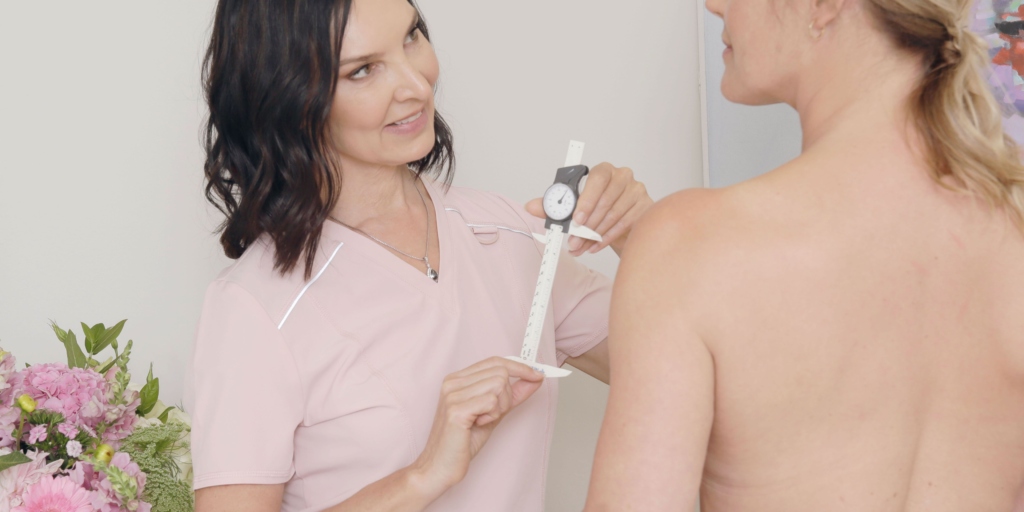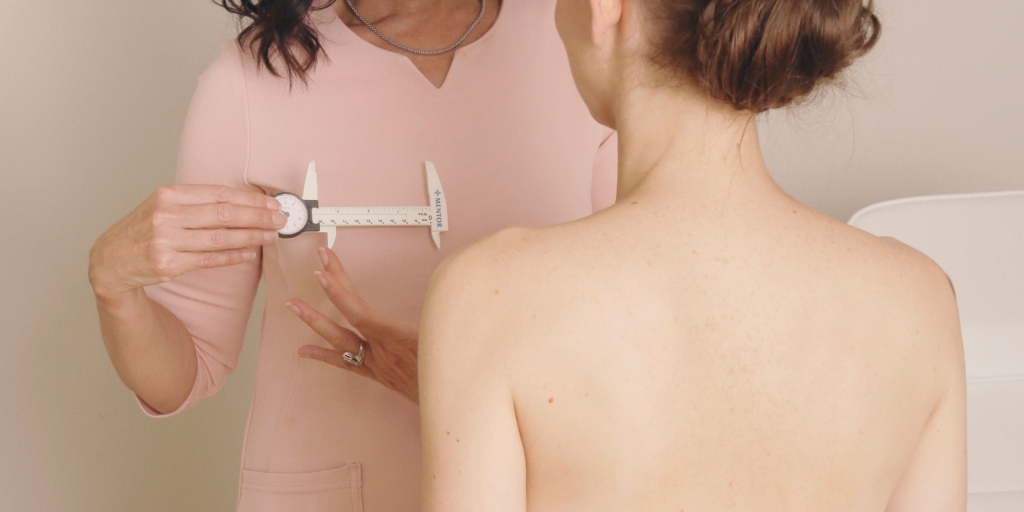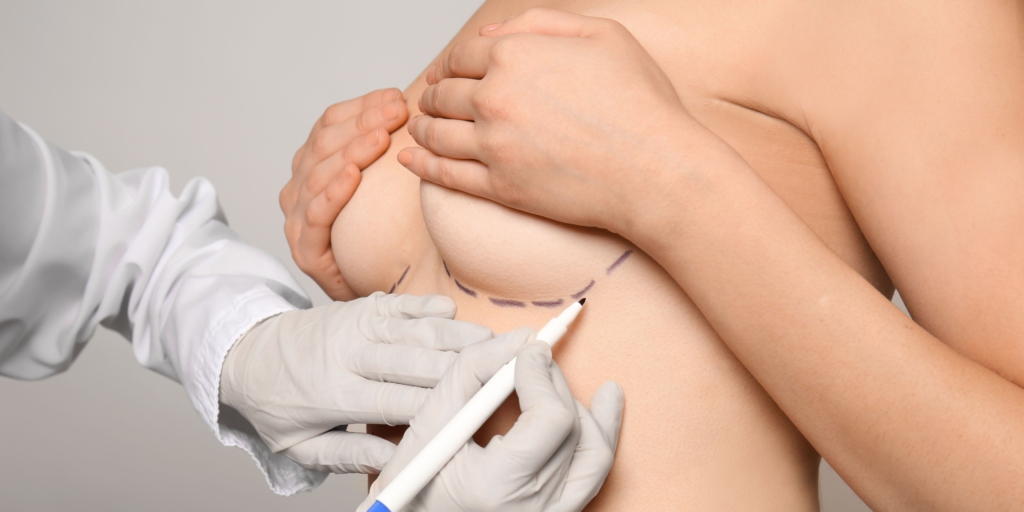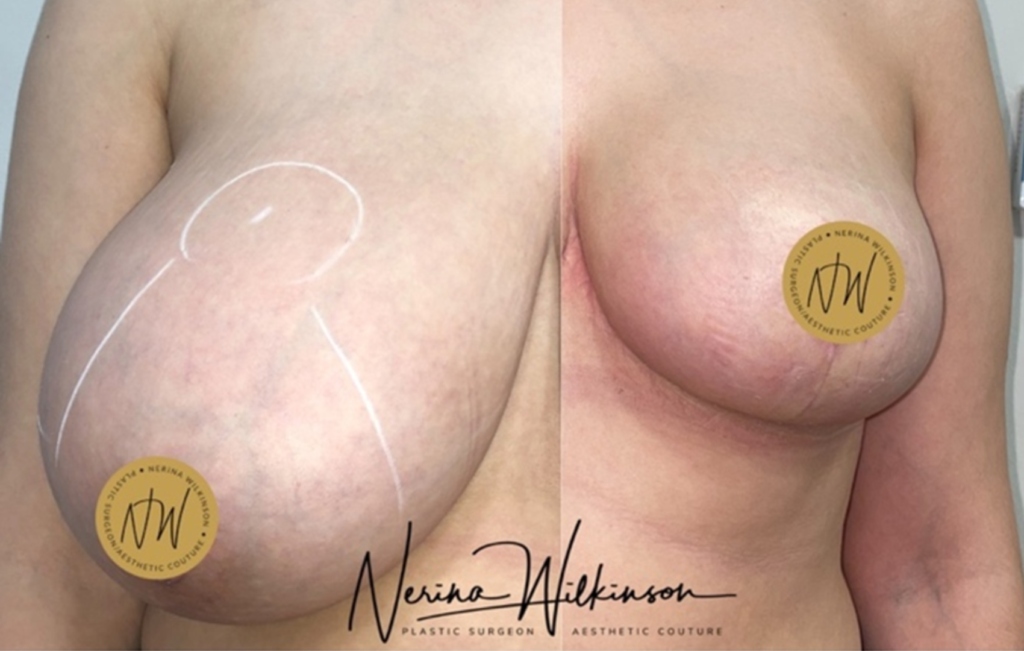by Cosmetic Breast Surgery Expert, Dr Nerina Wilkinson
As a plastic surgeon with over 25 years of experience, breast reduction surgery remains a procedure close to my heart for its significant impact on my patients’ lives. More than just an aesthetic enhancement, it is sought after for the remarkable improvements it brings to both physical comfort and psychological well-being.
In response to the growing demand, this blog will explore surgical techniques, benefits, risks, and alternative options, offering essential insights for those considering this life-changing procedure.
Join me for a comprehensive journey into the purpose and scope of breast reduction surgery, empowering you to make informed decisions on your path to comfort and confidence.
Understanding Breast Reduction: A Transformation for Comfort and Confidence
Breast reduction surgery is a procedure with the primary goal of reducing breast size to alleviate physical discomfort and enhance overall well-being. The surgical process involves the meticulous removal of excess fat, breast tissue, and skin, tailored to achieve proportional and aesthetically pleasing results. What sets this procedure apart is the emphasis on individualised surgical plans, crafted to align with each patient’s unique anatomy and desired outcomes.
By addressing both the physical and emotional aspects, breast reduction not only transforms the body but also empowers you to embrace a more comfortable and confident version of yourself. I cherish the moments when a patient arrives for their 6-month surgical follow-up with a whole new energy and sometimes even a new boyfriend….
Reasons for Choosing Breast Reduction Surgery: A Holistic Perspective
Breast reduction surgery is often a choice driven by a range of medical, physical, and psychological considerations.
Medical and Physical Discomforts: Chronic back pain and posture issues are prevalent challenges faced by individuals with disproportionately large breasts. The excess weight can strain the back muscles, leading to discomfort and potentially contributing to long-term spinal issues. Breast reduction serves as a solution by alleviating this burden, providing relief from persistent pain, and fostering improved spinal alignment.
Lifestyle Limitations: Large breasts can impose significant lifestyle limitations, impacting both daily activities and clothing choices. Engaging in physical activities such as exercise or sports may become challenging, limiting your ability to lead an active and fulfilling life. Moreover, finding suitable and comfortable clothing can be a constant struggle, influencing wardrobe choices and affecting personal style.
Psychological Impact: Beyond the physical realm, breast size can have a profound psychological impact on self-esteem and body image. Large breasts may lead to feelings of self-consciousness, societal pressures, and even discomfort in personal relationships. Choosing breast reduction surgery can offer a transformative journey towards improved self-esteem, body confidence, and an overall positive self-image, empowering women to embrace their bodies with newfound pride.
Evolution of Breast Reduction Surgery: A Journey Towards Innovation
The evolution of breast reduction surgery is a testament to the continuous refinement of techniques, prioritising both safety and aesthetic outcomes. Traditionally, breast reduction procedures employed the well-known ‘anchor’ or inverted T incision, aiming to remove excess skin to support sagging breasts. However, this approach, while effective, often resulted in longer scars and extended recovery times.
A significant advancement in modern breast reduction techniques is the introduction of the short scar/lollipop breast reduction. Departing from the conventional inverted T incision, this innovative approach focuses on creating an internal bra, enhancing breast shape with a much shorter scar. This technique not only minimises visible scarring but also contributes to improved safety during the surgical process.
The adoption of contemporary procedures emphasises enhanced safety, superior aesthetic outcomes, and quicker recovery times. Notably, liposuction of the lateral breast, addressing commonly known as “side boobs,” has become an integral component of modern breast reduction surgeries. This additional step enhances overall body contouring, providing a more comprehensive solution.
In embracing these advancements, patients undergoing a breast reduction benefit from not only improved safety measures but also aesthetically pleasing outcomes and a more efficient recovery period.
Benefits of Breast Reduction Surgery: A Comprehensive Transformation
Undergoing breast reduction surgery offers a myriad of benefits that extend beyond mere physical changes, providing you with a holistic transformation that positively impacts well-being.
Greater Relief from Physical Discomfort:
Breast reduction serves as a remedy for chronic back and neck pain, alleviating the physical burden caused by disproportionately large breasts. This relief extends to the reduction of physical limitations, allowing for a more active lifestyle without the hindrance of persistent discomfort.
Improved Posture and Mobility:
The reduction in breast size contributes to enhanced posture, a key benefit that positively affects overall spinal alignment. This improvement in posture, in turn, fosters better mobility, enabling you to engage more comfortably in daily activities and exercise routines.
Enhanced Proportion and Balance:
Beyond physical comfort, breast reduction brings about aesthetic benefits, creating a more proportionate and balanced figure.
Increased Self-Confidence and Body Image:
Addressing the psychological aspects, breast reduction offers relief from societal pressures and self-consciousness. Post-surgery, individuals experience a significant boost in self-esteem and confidence, embracing their bodies with newfound positivity.
Reduction in Skin Irritation and Infections:
Breast reduction minimises skin folds, decreasing the likelihood of irritation and infections. This not only contributes to physical comfort but also addresses dermatological issues associated with large breasts.
Expand Your Clothing Options:
Post-surgery, my patients enjoy expanded wardrobe possibilities, experiencing the joy and confidence that come with wearing desired clothing styles. This newfound freedom in clothing choices contributes to an overall sense of empowerment and self-expression.
Types of Breast Reduction for Personalized and Enhanced Comfort: Tailoring Solutions to Individual Needs
Breast reduction surgery offers a range of surgical options, each carefully tailored to meet the unique needs and preferences of individuals seeking enhanced comfort and well-being. The role of the surgeon in determining the most suitable technique is pivotal, ensuring a personalised approach to achieve optimal results.
Traditional Breast Reduction Surgery:
The traditional ‘anchor’ technique, characterised by an inverted T incision, is suitable for certain patients with very large breasts. This method allows for the removal of excess tissue, reshaping the breasts to achieve a more proportionate size. While effective, this approach comes with more visible scarring.
Short-Scar Breast Reduction:
The modern lollipop technique represents a refined option in breast reduction surgery. This method reduces scarring and promotes quicker recovery compared to traditional approaches. Ideal candidates for the lollipop technique are those seeking a less invasive solution, especially women with moderate breast volume who desire a subtle reshaping. The benefits of reduced scarring and enhanced recovery make this method appealing to those prioritising aesthetic outcomes and minimal downtime.
How Do I Pick the Right Breast Reduction Surgery?
Selecting the appropriate breast reduction surgery involves a comprehensive consultation with a qualified surgeon. Stressing the importance of this initial step, I encourage you to openly discuss factors such as breast size, skin elasticity, and personal goals with your surgeon. A thorough dialogue with your surgeon ensures informed decision-making, allowing for a tailored approach that aligns with your unique anatomy and desires.
Overview of the Safety of Breast Reduction, Complications, and Monitoring: Ensuring a Secure Journey
Before delving into the specifics of breast reduction surgery, it is crucial to outline the safety considerations and potential complications associated with the procedure. This serves as a foundation for a detailed exploration of post-operative care, complication management, and long-term monitoring to guarantee optimal recovery and results.
Is Modern Breast Reduction Safe?
Modern breast reduction surgery is supported by statistical data and research showcasing its safety and success rates. Advances in surgical techniques have significantly improved the safety of the surgery, contributing to enhanced outcomes.
These include:
- Tumescent Technique: This involves injecting a solution into the targeted area to numb it and constrict blood vessels, reducing bleeding and improving safety during surgery.
- Liposuction-Assisted Breast Reduction: Incorporating liposuction in the procedure not only helps in contouring but also minimises blood loss, contributing to a safer surgical experience.
- Minimal Incision Techniques: Modern approaches, such as short-scar or vertical incision methods, aim to minimise incisions.
- Improved Anaesthesia Practices: The use of refined anaesthesia protocols and medications ensures patient comfort while minimising associated risks, enhancing the overall safety of the surgical process.
These advancements collectively contribute to a safer and more sophisticated landscape in breast reduction surgery, prioritising patient safety and optimising outcomes.
Common misconceptions about the risks of breast reduction include overestimating scarring extent, fearing compromised nipple sensation, and concerns about breastfeeding difficulties.
Modern techniques have addressed these issues, emphasising minimal scarring, preserving sensation, and often allowing for successful breastfeeding.
Consulting with a qualified surgeon helps dispel these myths and provide accurate information.
Typical Risks and Complications Associated with Breast Reduction:
Breast reduction surgery, while transformative, involves certain risks that you should be aware of.
- Scarring of your breasts is a common concern, and despite efforts to minimise visibility, the extent varies based on the chosen technique.
- Changes in nipple sensation, either heightened or reduced, can occur temporarily or persistently.
- Achieving perfect symmetry is challenging, and subtle differences may persist post-surgery.
- Complications such as infection or bleeding are inherent risks, though advancements in surgical techniques and adherence to strict hygiene protocols have significantly reduced their occurrence.
- Skin necrosis, where skin tissue may not receive adequate blood supply, is another potential risk. However, modern approaches, including the use of local vasoconstrictors to reduce blood loss, have contributed to minimise this risk.
- Seroma, the accumulation of fluid under the skin, is a possible postoperative complication. While rare, it can be managed through drainage if necessary.
- Deep vein thrombosis (DVT) and pulmonary embolism, though uncommon, are critical risks associated with any major surgery. Surgeons often implement preventive measures, such as early mobilisation and compression stockings, to minimise these risks.
It’s essential to recognize that risks vary among individuals, and not everyone will experience the same issues. The key lies in thorough preoperative discussions with your surgeon, covering medical history, expectations, and potential complications. Adhering to post-operative care guidelines, attending follow-up appointments, and maintaining open communication with the surgical team are crucial steps to manage and mitigate these risks, ensuring a safe and successful breast reduction journey.
How Should I Monitor My Breast Reduction Surgery to Prevent Problems?
Monitoring breast reduction surgery during the recovery phase is crucial for identifying and addressing potential complications, and ensuring optimal healing. Recognizing signs of complications early on is essential for proactive healthcare.
- Watch for any unusual redness, swelling, or increased pain, as these may indicate infection or other issues.
- Changes in nipple sensation or discharge warrant attention, and if severe or persistent, consultation with your surgeon is necessary.
- Maintaining health during recovery involves adhering to post-operative instructions
- Avoid strenuous activities, follow prescribed medications, and maintain proper wound care.
- Supportive garments, as recommended by the surgeon, aid in minimising swelling and promoting healing.
- Adequate rest and a balanced diet contribute to overall well-being during recovery.
Regularly assess the incision sites for any abnormalities, ensuring they heal properly. If there are concerns about excessive bruising, persistent pain, or other unexpected changes, immediate consultation with the surgical team is advised. Staying hydrated and managing stress also support a smooth recovery process.
Follow-up appointments are vital for successful healing. They allow the surgeon to assess progress, address concerns, and make any necessary adjustments. Open communication about any changes or discomfort experienced post-surgery is crucial during these appointments. Your surgeon may provide additional guidance based on individual recovery trajectories.
In summary, vigilant monitoring involves recognizing signs of complications, maintaining overall health during recovery, and prioritising follow-up appointments. This collaborative approach between you and your surgical team ensures a comprehensive and successful breast reduction journey.
What are the Long-Term Effects of Breast Reduction on My Breast Health?
Long-term effects of breast reduction surgery often yield positive changes in breast health. Although there may be initial alterations in sensation after breast reduction surgery, such as temporary numbness or heightened sensitivity, these typically improve over time. The reduction in breast size and weight contributes to lasting relief from physical discomfort, fostering a more comfortable and mobile lifestyle. The reshaping of breast tissue aims to enhance overall breast health, with many individuals experiencing sustained benefits in terms of comfort, proportion, and improved overall well-being.
It’s crucial to acknowledge that breast reduction surgery can impact mammograms and breast examinations. The rearrangement of breast tissue may influence the imaging process, necessitating specialised techniques for accurate readings. Individuals who have undergone breast reduction should proactively inform their healthcare providers, ensuring appropriate adjustments are made during screenings to maintain the effectiveness of breast examinations. This collaborative approach between individuals and healthcare professionals enhances the accuracy of screenings and promotes ongoing breast health.
Discussing potential long-term changes in breast tissue and sensation provides individuals with a comprehensive understanding of the post-surgery experience. Addressing the impact of reduction on mammograms and other breast examinations ensures clarity on the ongoing care required. Ultimately, this blog is to provide you with reassurance regarding the overall positive long-term effects on breast health, fostering confidence in your decision to undergo breast reduction surgery.
It is important to prepare yourself with the knowledge to navigate the safety aspects, potential complications, and ongoing monitoring involved in breast reduction surgery, fostering a sense of security and informed decision-making.
Alternatives to Breast Reduction: Exploring Options for Personalized Comfort
When considering options for breast reduction surgery and breast size management, you have both surgical and non-surgical alternatives to explore, each with its unique benefits and considerations.
Surgical Alternatives:
- Breast Lift Surgery: A breast lift, distinct from reduction, involves reshaping the breasts to achieve a lifted and more youthful appearance. Ideal candidates for a breast lift may seek to address sagging or drooping breasts without necessarily reducing their size. The expected outcomes include improved breast contour and elevation, contributing to a rejuvenated aesthetic.
- Liposuction: Introducing liposuction as a less invasive option for breast size reduction emphasises a targeted fat removal approach. While suitable for certain cases, liposuction has limitations in addressing glandular tissue, making it important to carefully consider its appropriateness for individual cases.
Non-Surgical Alternatives:
- Weight Loss and Exercise: Natural reduction of breast size can be achieved through weight loss and regular exercise. This approach may be suitable for individuals with a significant proportion of breast tissue composed of fatty deposits. However, it’s important to caution that the effectiveness of this method varies based on individual breast composition.
- Supportive Clothing: Specially designed supportive clothing can offer temporary relief by providing better breast support and minimising discomfort. While helpful in the short term, relying solely on supportive clothing may have limitations in providing long-term comfort and addressing the underlying causes of breast-related issues.
It’s crucial to acknowledge that while these alternatives can be beneficial, they may not yield the same transformative results as surgical breast reduction. The appropriateness of each alternative depends on your individual goals, anatomy, and preferences. A thorough consultation with a qualified professional can guide you in selecting the most suitable option for your unique needs and desired outcomes.
Final Thoughts on Breast Reduction Surgery: A Journey to Comfort and Confidence
Having breast reduction surgery is more than a cosmetic enhancement; it is a life-changing decision that addresses physical discomfort, enhances aesthetic proportions, and uplifts psychological well-being.
What are your Key Benefits: Breast reduction surgery provides a holistic solution, offering relief from chronic back and neck pain, improving posture, and enabling a more active lifestyle. The aesthetic benefits of the surgery include enhanced proportion and balance, fostering a positive self-image and increased confidence. Beyond physical changes, the procedure brings about emotional liberation, freeing women from societal pressures and self-consciousness.
Professional Guidance and Individualised Decision-Making: The significance of seeking professional guidance cannot be overstated. A qualified surgeon plays a pivotal role in tailoring the approach to your individual anatomy, goals, and preferences. The emphasis on individualised decision-making ensures that the chosen procedure aligns seamlessly with your unique goals.
To further empower you on your journey of understanding breast reduction, I encourage you to explore additional resources. Delve deeper into the specifics of short-scar breast reduction by reading our post titled ‘What is a short-scar breast reduction & how does it work?’ for insights into modern techniques.
Additionally, broaden your knowledge on related topics with ‘Everything you need to know about breast lift surgery.’ By actively engaging with these resources, you are taking a proactive step toward informed decision-making and a comprehensive understanding of transformative surgical options.
For personalised guidance on your journey to comfort and confidence through breast reduction surgery, contact Dr. Nerina Wilkinson + Associates. Experience the epitome of aesthetic excellence with our expert team.










